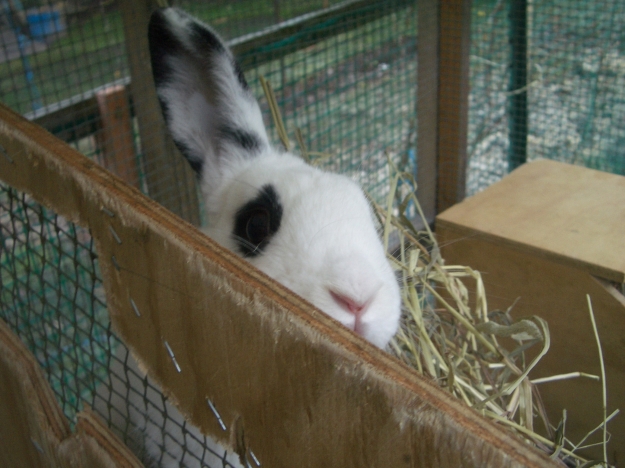So I have been mentally reviewing the backyard bunny project, and here is how we did this year:
We mated both does twice in 2011. Momma bunny (who is a somewhat unwilling breeder and not very fond of Poppa bunny generally, but a good mom) had two litters of kits. The first litter was 7 baby bunnies, the second litter was 8, for a total of 15 baby bunnies. This was her second year of raising babies.
Snacks was new to the game, but was a champ and a great mom. She rather likes Poppa bunny.
Her first litter ever was 11 kits, three of which she either killed or were still born, but she raised up 8 in the first batch and 10 in the second batch, for a total of 18 kits. We gave away two kits to our niece, and butchered the rest, so produced for ourselves 31 meat rabbits. We figured that for organic bunny kibble it costs about 7.50$ a rabbit (half a bag of bunny pellets per kit), plus maybe another dollar’s worth of hay to raise a kit from newborn to 10 weeks, which is when we typically butcher. At somewhere around 3# a processed bunny, that is pretty cheap organic meat. The bunnies also produce great fertilizer, which we compost for 3-6 months and then use in the garden. Labor is not included in these costs, but it takes about 15 minutes a day to feed and water three bunny pens, and it is the same whether we have kits or not. The bunnies also get fruit and greens from the garden, grass, apple trimmings and berry canes as a food supplement. Commercial rabbitries will have does produce up to 5 litters a year, but my sense is that is a lot to ask of a bunny doe year in year out. You can literally mate a doe the day after she gives birth, but that doesn’t mean I think I should.
The one thing about the bunnies that I have yet to work out is that I would really like to have a larger communal play space that they can use when they are not breeding, so the does at least can keep each other company, and everyone can get more exercise. The bunnies have big pens, but I still feel like their quality of life is less than that of the chickens, who at least get to get out and run around in the yard for a few hours. There is an interesting article on bunny quality of life issues in the lab here. I think these approaches could be incorporated into a meat rabbit setting without too much extra work. Joel Salatin’s movable fryer pens are another approach to this issue of letting rabbits be rabbits, but I don’t know if the breeding adults also get to get out on grass or if it is just the young stock. Being able to raise the young bunnies on grass would also probably reduce our overall feed costs, though it would increase the labor somewhat. Our urban yard is currently too small for a pastured meat operation….but there may be room for a bunny play pen.
For those of you who have never eaten rabbit, well, you should. They are delicious. If you are like me and prefer the dark meat on a chicken or a turkey, then I guarantee you will love rabbit. We basically cook them all the same ways we would cook a chicken. They are excellent brined and roasted, fried in batter, or our favorite current rabbit recipe, braised with mushrooms and tomato sauce. Here is the recipe for ‘Rabbit Marengo’, a chicken recipe adapted from the Fannie Farmer Cookbook:
1 young rabbit cut into pieces
one onion, diced small
1/4 cup white wine
mushrooms (about a cup or so? we eyeball it)
tomato sauce (we usually use somewhere between a pint and a quart)
flour
olive oil
salt and pepper
Cut the rabbit up into pieces and dredge in a mixture of flour, salt and pepper. In a saucepan heat olive oil and then brown the floured pieces of rabbit on both sides. Set aside. Add a little more oil to the pan and cook the diced onion until translucent, and then add the mushrooms and cook until browned. Add the white wine and reduce for a few minutes. In a braising pan (we use a Le Crueset braising pan but a heavy cast iron pan wit an ovenproof lid will work too) place the rabbit pieces in first and then coat with the wine/onion/mushroom mixture, and cover with tomato sauce. Cover and braise in a 350 degree oven for about 50 minutes.
We usually serve this with homemade bread, a big green salad, and a nice local pinot noir. My husband came home this week with a backpack full of porcini mushrooms, so I look forward to making this with some wildcrafted queen boletes soon.





i love this!
Thank you!
Not sure if you are still raising rabbits at this point but you might want to check into Skyview Acres (I know them on FB)- they are kindling on pasture in porta-rabbit hutches, super cool! We had bad luck with predators and rabbits, even with mesh bottom rabbit tractors.
We have a dog who will field test all of our animal hutches….if she can’t get into it, the coyotes and raccoons don’t stand a chance. Even so, I will probably kindle in colony or hutch first, and then move them onto grass when the kits are big enough to hop around. I will check out Skyview, thanks for the suggestion! Always looking for pastured rabbit people….